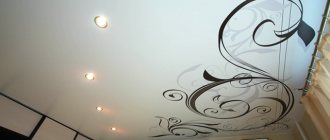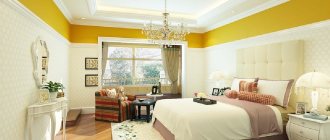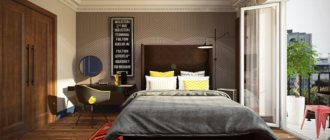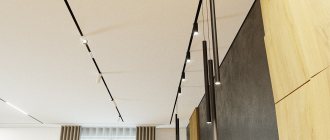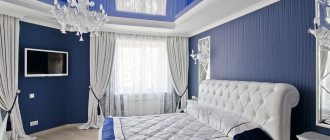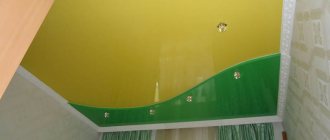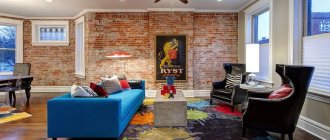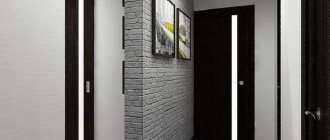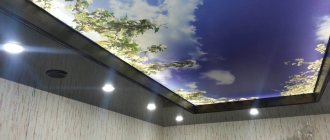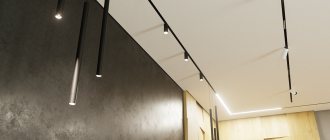Lighting plays an important role in the decor of a room. A correctly selected arrangement of lamps on a suspended ceiling or other decoration can transform a room beyond recognition; in a large hall, the space can be zoned, and a small area can be visually expanded. As an example, we will give several typical lamp placement schemes, and also present interesting design solutions for various types of premises. Since spot lighting (spots) is now popular in interior design, maximum attention is paid to it.
Lamps for suspended ceilings
Location Features
Types of devices
Lamps used
Installation of ceiling models
Location: photos and diagrams
Lighting options
Lamps not only perform the function of lighting, but also decorate the room, giving it uniqueness and special comfort. When choosing lighting fixtures, take into account the general idea of the design, as well as the features of the surface to which they will be attached. Lighting in a kitchen with a suspended ceiling has its own nuances, which we will consider in the article.
Photo: Instagram @prinesibobra
Photo: Instagram @deluxe_od.com.ua
Photo: Instagram @migcomservice
Spot layouts without a chandelier
In a number of rooms, spotlights take on the main role in organizing lighting due to the lack of possibilities for installing a central chandelier. Also, the latter can often look like a foreign element in certain interiors, for example, in a narrow corridor or a small bathroom. In cases where the use of a chandelier is inappropriate, the correct placement of spot spots on a stretch ceiling takes on additional importance.
The most common options for using spots in such cases are discussed in detail in the diagram below.
Again, this is what it looks like in a variety of interiors.
Features of the location of lamps in a kitchen with a suspended ceiling
When choosing lighting, you need to take into account the features of stretch fabrics. They are made from PVC film or fabric. With constant heating above 60 degrees, the film may darken and melt. The fabric is more stable and can withstand temperatures up to 80 degrees. It is advised to adhere to several rules:
- choose lighting fixtures that do not heat up too much;
- choose incandescent lamps with a power of up to 60 W, and halogen lamps with a power of up to 30 W, while it is important to maintain a distance from the lighting fixture to the panel. It must be at least 30 cm;
- If possible, use LED and energy-saving varieties, since they hardly heat up during use.
Photo: Instagram @prinesibobra
Photo: Instagram @prinesibobra
Photo: Instagram @migcomservice
- Lighting
How to choose a chandelier for your interior: options for 8 popular styles
Halls
Very large rooms, especially in private homes, need fairly powerful lighting. In this regard, entrusting the solution of this problem solely to spots is an extremely unwise and expensive solution. It is appropriate in such cases to use a combined option
a classic chandelier in the center, and along the perimeter, place numerous spotlights at equal distances from each other. This lighting option will create maximum comfort in the room and saturate it to the limit with air and a healthy atmosphere.
Types of lighting fixtures
Based on their design, lighting fixtures are divided into four groups.
Chandeliers
They are still in demand, despite the emergence of more modern accessories. Manufacturers offer a good selection of models: from classically shaped lampshades to designer options made from unusual materials. To prevent the stretched panel from heating up, it is better to choose designs whose shades look down or to the side. It should be taken into account that the glossy surface reflects light. Therefore, chandeliers with shades will look good here. For film material, the distance to the heating zone is critical, so it is better to choose a longer chandelier suspension.
Photo: Instagram @_marina_ky
Photo: Instagram @_marina_ky
Photo: Instagram @_marina_ky
Spot
They are at the peak of popularity, which is not surprising: they do not heat up, have different mounting options, are durable and simply beautiful. Since the kitchen is often humid, it is better to choose models with a moisture-proof housing. To obtain bright or diffused light, you can choose transparent or frosted glass, respectively. And with the help of colored glass you can create unusual patterns on the surface. During installation, you can make electrical wiring to turn on the lights only in the areas needed at the moment. To calculate the required number of spotlights, you need to know the generally accepted lighting standard. It is 20 W per 1 sq.m of room.
Photo: Instagram @vgceiling
Photo: Instagram @mix_svet
Photo: Instagram @migcomservice
Spots
A variety of point models that are not built into the ceiling surface, but are attached to it or to the walls on a movable bracket. Due to their mobility, they create a directed beam of light. The control controller helps you adjust the intensity of the glow. These types are good for zoning a room, illuminating the desired part of it, or focusing attention on interior details. Spots can be single or complex, with several cartridges on one platform. If the spot itself is rather ascetic in appearance, then the platform can become an interior decoration.
Photo: Instagram @mix_svet
Photo: Instagram @prinesibobra
LED strips
The design looks like a flexible printed tape on which small LEDs, white or colored, are attached. Such ribbons run around the perimeter of the room, visually increasing its area. The reverse side of the tape is sticky, so it is easy to attach. The tape is connected to the network via a power supply. And controllers are used to control the brightness of the glow.
Photo: Instagram @migcomservice
Photo: Instagram @horizon_line_krd
- Lighting
9 ways to make your home more comfortable with LED strips
Photo examples of interesting options
Here are some successful lighting design solutions for various types of premises. Examples will include both standard schemes and original compositions.
For the corridor and hallway
In such rooms there is no need for bright lighting, therefore, there is no need to install a central chandelier. The sources are installed along the walls or along the entire perimeter; if there are mirrors, it is advisable to additionally illuminate them using wall lamps.
Classic corridor lighting scheme, suitable for almost any interior
Below is a similar option, but with a central chandelier.
Option with central chandelier
If the corridor is narrow, then place spotlights in the middle, creating a light path; if necessary, you can make additional lower lighting on the walls, as shown below.
An example of a light path laid along the center of the ceiling in a narrow room
A similar arrangement is also possible on a multi-level ceiling, as can be seen from the figure; this version is more original.
Multi-level stretch ceiling with light track
If the corridor has a glossy stretch ceiling, then upward-facing soffits look good as additional lighting. Their rays reflected in the ceiling will create an interesting play of light.
The use of flashlights (spotlights) for additional lighting
Lamps on a suspended ceiling do not have to be installed at equal distances from each other; the asymmetrical design looks quite original.
Asymmetrical hallway lighting scheme
For small square hallways, we can recommend a classic scheme for 5 lamps. It is shown in Figure 1 (A), and the chandelier can be replaced with a ceiling lamp.
For kitchens
This type of room is rightfully considered the brightest; it is problematic to prepare food in the twilight, in particular, cutting vegetables. Therefore, proper kitchen lighting needs to be given special attention. This is greatly facilitated by the division of the room into zones, in one there is cooking, in the other there is a dining table, etc. In such cases, lamps are installed in accordance with the interior, room layout and level of natural light.
Of the typical options in Figure 1, schemes “I” and “K” are best suited for such purposes.
Example of implementation of scheme I for 10 lamps
Option “K” is more suitable for spacious rooms.
Example of scheme "K"
It is not at all necessary to use the above schemes; you can find other solutions, the main thing is that there is enough light in the work area.
The kitchen work area should always be well lit
It is equally important that the lamps are also directed towards the dining table, as shown in the example below.
The dining table is located under the central chandelier
It is not at all necessary to use a hanging chandelier; if the spots are positioned correctly, you can do without it.
Kitchen lighting without a pendant chandelier
Below is another version of a “chandelier-less” scheme for a kitchen with a ceiling panel.
Solution for multi-level stretch ceiling
For the hall
This is the largest room in the house, and since it is considered the main room, it should correspond to this status. For large areas, the classic scheme with the main lamp in the form of a pendant chandelier and additional illumination of areas may not be effective. In such cases, it is better to use a uniform arrangement of lamps on a stretch ceiling.
Uniform lighting of the hall
As an alternative, you can consider schemes with uneven placement of lamps on the ceiling. In such cases, spots can be concentrated in different parts of the room, creating zonality.
Example: Uneven placement of luminaires
This method of placement is perfect for studio apartments, which essentially consist of one large hall. With the correct placement of spots, a large room can easily be divided into several zones.
Example of zoning in a studio apartment
A good option would be to install several lamps on the ceiling in an oval, while the figure can be divided into several segments that can be switched on separately.
Lamps can be arranged in the form of geometric shapes
Solutions with multi-level suspended ceilings on which spots are installed look good.
Illumination of a hall with a multi-level ceiling
When choosing a scheme, be sure to take into account the interior design, since choosing a different solution will require major renovation work.
Light scheme creates zonality
For the bedroom
In fact, this room is a continuous recreation area, therefore, it is necessary to maintain moderate lighting.
Light in the bedroom should be moderate
If there is not enough light, you can always install additional sources in the form of a sconce or floor lamp.
If necessary, you can install a sconce or floor lamp near the bed
If we consider classic schemes (see Fig. 1), we recommend paying attention to two options “E” (8 lamps) and “H” (12 lamps). A small pendant chandelier framed by several LED strip figures also looks good.
Chandelier, LED strips and several spotlights
You can choose an option with imitation of the starry sky; an example of the implementation is presented below.
Grouped small sources for a starry sky effect
Please note that the interior can also influence lighting. Light reflected from the drapery acquires its shade. This is clearly visible in Figure 24, where ordinary “warm” white light lamps are used to illuminate the room. The interior adds red undertones.
An example of the influence of the interior on lighting
There are no restrictions on your imagination; you can create something fabulous and unusual.
Bedroom lighting in a futuristic style
For living rooms
This type of room differs from a hall in its smaller area, so it is better to use schemes with a central powerful source (chandelier) in the middle of the room with additional spots. The latter can be located around the perimeter or highlight the corners of the room. If we consider the classic options (see Fig. 1), then we can choose the following schemes: A, C, D, F, G, J and L. Each of them fully satisfies the conditions of the problem.
An example of classic lighting according to the “C” scheme
Moreover, the perimeter does not have to have the correct shape; the absence of right angles creates a completely different mood.
Interesting lighting solution around the perimeter
There is no need to install lighting above the seating area; it can be successfully replaced by sconces.
Sconce in the recreation area
In the living room, as in the hall, you can completely abandon hanging chandeliers if you use several powerful lamps with an outdoor location.
Oval made from outdoor light sources
An LED strip in a multi-level plasterboard ceiling will cope with lighting the living room no worse than a chandelier.
Lighting scheme using built-in lamps and LED strip
If the living room is small, it is enough to just install spots around the perimeter.
Classic scheme without chandelier
For children's room
As a rule, such rooms are zoned for sleeping, studying and a play area. Accordingly, a group of additional lamps should be installed on the suspended ceiling above the table, and sconces should be placed near the cribs.
It is necessary to install sconces in the sleeping area
Alternatively, a table lamp can be installed on the desk.
Table lamp as an additional light source
Since a children's room is often a playground, a chandelier in the room is not desirable. If children play too much, they can damage it. Uniform placement of powerful spots allows you to do without a bulky chandelier.
It is better not to install a hanging chandelier in the nursery
Proper lighting will help create a bright, fairy-tale atmosphere in the nursery.
The correct scheme will fill suspended ceilings with photo printing with colors
Photo wallpaper will take on a more realistic look. Multi-colored lighting will create the illusion of a fairy tale.
For the bathroom
Since in standard panel houses this room is not large in size, you can opt for option “B” with 6 lamps (see Fig. 1). For such a situation, it is not even necessary to implement the entire scheme; it is enough to choose one of two types of lamps for the ceiling. If necessary, you can install sconces or rotating lamps near the mirrors.
One of the simplest bathroom lighting options
If the bathroom is larger, then the scope for imagination expands significantly. You can use the classic version with evenly spaced spots.
Evenly spaced bathroom fixtures
Light can emphasize zoning.
Zoning using light
Another option for emphasizing zoning
Use a technique to give the light the desired shade.
Due to the color of the tiles and stretch ceiling, the light is given a light green tint
Option with a warm blue tint
Lamps used for lighting in the kitchen with a suspended ceiling
When choosing spotlights, you need to think about what lamps will be used in them. In our case, the following types are used.
- Incandescent lamps (base E27, E14) are loved by buyers despite other, more modern varieties. They provide a warm light that is pleasant to the eye, do not flicker, and are inexpensive. A serious disadvantage is their rapid and strong heating. Therefore, for pendant models, light bulbs with a power of up to 60 W are chosen. For built-in ones, it is better to choose other types.
- Halogen lamps are a more modern type of incandescent lamp. They shine brighter and last longer, but they cost more. Halogen lamps emit a light spectrum close to daylight. However, they also get very hot. For PVC canvases, it is recommended to choose lamps with a power no higher than 35 W.
- Luminescent ones do not heat up, therefore, they can be safely used next to film sheets. They can create both cold and warm radiation. This allows you to select a shade suitable for the interior. Energy-saving lamps are more expensive than incandescent lamps, but they consume five times less energy and last longer.
- LEDs are the leaders in all respects. They do not heat up, consume little energy, are bright and durable. Their glow spectrum is similar to daylight, and their small size allows them to be used in any design. The only negative is the rather high price compared to other types.
Increasing/reducing space
The ability to choose the right spotlights can greatly help in correcting some of the existing shortcomings of the room. In particular, the persistent shortage of square meters and the general state of constriction in overly small rooms can be solved with the help of several lamps hidden behind the eaves. And if you add an LED strip to them, you can get an excellent lighting scenario that will allow you to forget about all the shortcomings of the room.
Installation of ceiling lamps
Based on the shape of the structure and type of installation, they can be divided into three groups.
Hanging
Mounted on a hook in the ceiling. The chandelier has fasteners with which the structure is suspended. When installing, a hole is made in the canvas through which the suspension is pulled. It is recommended to choose large chandeliers for spacious rooms, while respecting the chosen interior style. Particular attention should be paid to the length of the fastening. Between the main ceiling and the stretched ceiling there is a space that will hide part of the suspension. It is important that the device is not too close to the stretched fabric.
Photo: Instagram @prinesibobra
Photo: Instagram @prinesibobra
Built-in
They consist of a housing, a light bulb with a diffuser and a mount. The housing is completely or partially recessed (built-in) into the ceiling plane. Its shape can be round, square or rectangular. There are models that illuminate only the space underneath (they are called downlights) and those that rotate in different planes, changing the direction of the beam.
Photo: Instagram @vgceiling
Photo: Instagram @swg_ru
The appearance of the device can be chosen to suit your taste: flat or with a convex shade in the form of a cone, ball, polygon or cylinder.
Photo: Instagram @zdes_svetPhoto: Instagram @zdes_svet
Photo: Instagram @zdes_svet
Photo: Instagram @zdes_svet
Overlay rings are decorated with pendants or decorative patterns. The models are ideal for illuminating a two-level upper structure. This way you can select one level or all at once.
Photo: Instagram @zdes_svet
Photo: Instagram @zdes_svet
Photo: Instagram @zdes_svet
Photo: Instagram @zdes_svet
Invoices
Installed using a platform on the ceiling canvas. The main selection criterion is lightness. Most often this type is represented by LED models. They are lightweight, yet they shine brightly and do not heat up. The design of their lampshades is varied. The platform can be stylized to resemble precious metals.
Photo: Instagram @divine_light.ru
Photo: Instagram @prinesibobra
Photo: Instagram @e.okna
- Lighting
How to remove a spotlight from a suspended ceiling and replace it with a new one
Adjustment type
All of the above types of spotlights can also differ in the type of adjustment. Depending on this, spotlights are:
- non-rotating – illuminate part of the room, but the direction of the light flow cannot be adjusted;
- rotating - allow you to adjust the angle of incidence of light and its direction;
- rotating and retractable spotlights are used to change lighting zones.
In terms of functional features, spotlights can also vary significantly. Modern models are equipped with remote control, have a wider angle of light incidence, protection against dust and moisture, and other functions.
How to choose
An important criterion when choosing lamps in the interior is their design, which is consistent with the style of the room. For a classic room, you can choose models with ornaments or crystal pendants. In a room with a modern design (modern, high-tech, loft) standard white lamps of a simple shape are suitable. In addition to the appearance and material of the lampshade (it can be glass or acrylic), when choosing, pay attention to the following details:
- Design. If the ability to change the angle of light is important, pay attention to rotating lamps.
In a modern interior Source leporte.net
- Base type (usually GU10 or LED).
- Dust and moisture protection class. Important when installing in a bathroom, open veranda or kitchen.
- Possibility of changing the type of lamp (LED instead of halogen).
- Possibility of connecting a dimmer.
In the dining area Source midway1942.org
Bathroom/toilet
As a rule, such functional rooms require a moderate amount of light, so it is quite possible to limit yourself to a dozen spots. There are glossy tiles on the walls and you definitely want to highlight this detail of your interior? Spotlights on the ceiling will help you with this.
When arranging spotlights in any sanitary facilities, it makes sense to adhere to strict geometry - this allows you to organize a small space.
